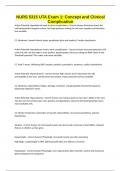NURS 5315 UTA Exam 1: Concept and Clinical
Complication
Action Potential: Hypokalemia leads to what complications - Correct Answer Potassium leaves the
cell leaving behind negative anions, cell hyperpolarizes making the cell more negative and therefore
less excitable
CC: Weakness, Smooth Muscle atony, parathesias (pins and needles), Cardiac dysrythmias
Action Potential: Hyperkalemia lead to what complications - Correct Answer Increased potassium will
come into the cell and make it more positive, depolarization will occur taking the RMP closer to the
Threshold potential. This makes cells more excitable.
CC: Peak T waves, Widening QRS Complex, paralysis, paresthesia, weakness, cardiac dysrhythmia
Action Potential: Hypercalcemia - Correct Answer High calcium (Ca2+) decreases the cells
permeability to Na+ ions. Cell becomes less positive. Hyper polarized and less excitable
CC: Weakness, hyporeflexia, fatigue, lethargy, confusion, encephalopathy, Shorted QT segment,
Depressed widened T waves
Action Potential: Hypocalcemia - Correct Answer Less Calcium leads to more per i ability of Na+ ions
into the cell. The cell becomes more positive and depolarizes. Closed to threshold potential means
more excitable cells.
CC: Tetany (involuntary contraction of muscle), hyperreflexia, circumoral paresthesia, seizures,
dysrythmias
Atrophy - Correct Answer CC: Decreased muscle size due to lack of exercise or bed ridden, reduced
thymus in children as they grow
Hypertrophy - Correct Answer Physiologic: Increased muscle size when exercising
Pathologic: cardiomegaly in HTN, kidney growth when one kidney is removed
Hyperplasia - Correct Answer Physiologic: Liver regeneration after resection, uterine and mammary
gland enlargement in pregnancy
, Pathologic: Endometrial lining in response to estrogen (Endometrial Cancer)
Metaplasia - Correct Answer Pathologic: Chronic Smokers Columnar cells to Squamous cells, Barrett
Esophagus (Normal squamous epithelial cells replaced by columnar cells) in response to heart burn,
GERD
Dysplasia - Correct Answer Dysplastic cells of the cervix during a papsmear, pre cancerous
Sickle Cell Anemia can cause what type of cell injury? - Correct Answer Hypoxic injury
A decrease in the production of red blood cells happens with what type of conditions? - Correct
Answer Iron Deficiency Anemia
Leukemia
Hypoxic injury of the muscle cells including the heart will release which enzyme? - Correct Answer
Creatinine Kinase
Hypoxic injury if the muscle cells, liver cells, lung cells, heart, RBC, and brain will release which
enzyme? - Correct Answer LDH (Lactate Dehydrogenase)
What free radical plays a part in all of the following conditions: Heart Disease, Alzheimer's Disease,
Parkinson's Disease, Amyotrophic Lateral Sclerosis - Correct Answer Reactive Oxygen Species (ROS)
What are examples of Antioxidants that can fight against Reactive Oxygen Species (ROS)? - Correct
Answer Antioxidants, Vitamin E, Vitamin C, beta carotene, flavonoids, cysteine, glutathione, albumin,
ceruloplasmin and transferrin
Alcohols consumption leads to what type of damage? - Correct Answer Liver damage
Nutritional deficiencies
Wernicke Encephalopathy
Peripheral neuropathy
Korsakoff Psychosis




